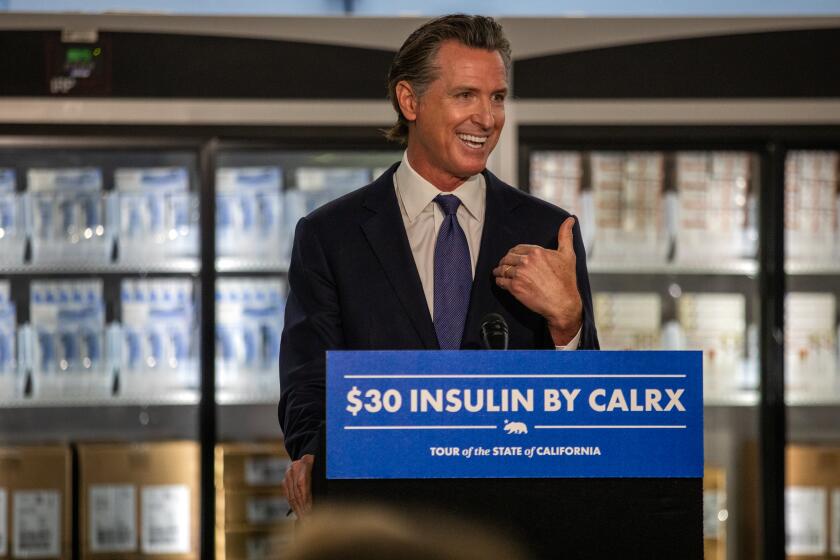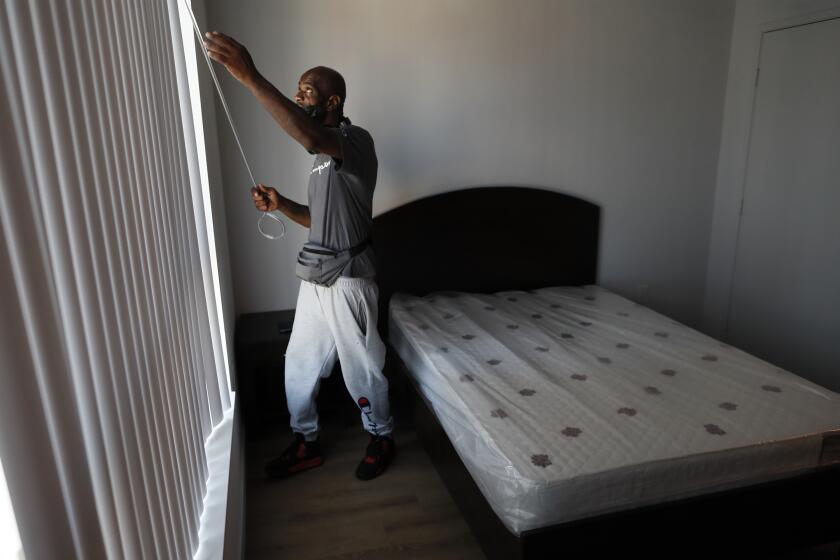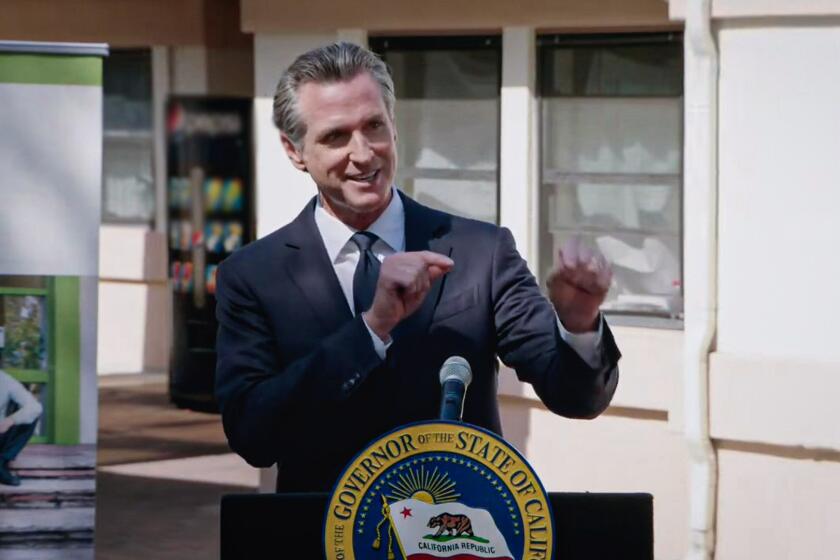Healthcare is Newsom’s biggest unfinished project. Trump complicates the task

- Share via
- As Gov. Gavin Newsom enters the second half of his final term, healthcare stands out as his most ambitious but glaringly incomplete initiative for California residents.
- The issue will probably define his national profile for better or worse, and the incoming Trump administration brings a new wrinkle.
SACRAMENTO — Nearly six years after he took office vowing to be California’s “healthcare governor,” Democrat Gavin Newsom has steered tens of billions in public funding to safety net services for the state’s neediest residents while engineering rules to make healthcare more accessible and affordable for all Californians.
More than a million California residents living in the U.S. without authorization now qualify for Medi-Cal, the state’s version of Medicaid, making the Golden State among the first in the nation to cover low-income people regardless of their immigration status. The state is experimenting with Medicaid money to pay for social services such as housing and food assistance, especially for those living on the streets or with chronic diseases. And the state is forcing the healthcare industry to rein in soaring costs while imposing new rules on doctors, hospitals and insurers to provide better-quality, more accessible care.
However, Newsom has so far failed to fully deliver on his most sweeping healthcare policies — and many changes are not yet visible to the public: Healthcare costs continue to rise, homelessness is worsening, and many Californians still struggle to get basic medical care.
Now, some of the governor’s signature health initiatives, which could shape his profile on the national stage, are in peril as President-elect Donald Trump returns to the White House. According to national health policy experts, California stands to lose billions of dollars in healthcare funding should the Trump administration alter Medicaid programs, as Republicans have indicated is likely. Such a move could force the state to dramatically slash benefits or eligibility.
And although the plan allowing immigrants without legal status to enroll in free healthcare has been funded almost entirely with state money, it makes California a political target.
“That is fuel to feed the Republican MAGA argument that we are taking tax dollars from good Americans and providing healthcare to immigrants,” said Mark Peterson, a healthcare expert at UCLA, referring to the “Make America Great Again” movement.
Newsom declined an interview for this article with KFF Health News. In a statement, he acknowledged that many of his initiatives are works in progress. But although he will attempt to work with Trump, the governor vowed to protect his healthcare agenda in his final two years in office.
“We are approaching the incoming administration with an open hand, not a closed fist,” Newsom said. “It is a top priority of my administration to ensure that quality healthcare is available and affordable for all Californians.”
Mark Ghaly, a former Health and Human Services secretary under Newsom, said transforming the way healthcare is paid for and delivered can be bumpy. “We didn’t do it perfectly,” Ghaly said. “Implementation is always messy in a state of 40 million people.”
Ahead of Trump’s Jan. 20 inauguration, Newsom has proposed allocating $25 million for expected litigation against Trump on reproductive healthcare, disaster relief and other services. His request is pending in the state’s Democratic-controlled Legislature.
Here are the major initiatives that will shape Newsom’s healthcare legacy:
Medicaid
Potential federal cuts loom large in America’s most populous state. Of the whopping $261 billion California spends annually on healthcare and social services, nearly $116 billion flows from the federal government. Most of that goes to Medicaid, which covers more than 1 in 3 Californians. GOP leaders in Washington have floated ideas to kneecap Medicaid, which could slash benefits or cut enrollment.
In addition, California’s expansion of Medi-Cal to 1.5 million immigrants without legal status is projected to cost the state roughly $6.4 billion for the fiscal year ending June 30. Newsom suggested this month that the state would continue to fund the immigrant healthcare expansion in the upcoming budget year but declined to say whether he would preserve the coverage in future years.
Advocacy groups are readying to defend those benefits should Trump target California over the issue. “We want to continue to protect access to care and not see a rollback,” said Amanda McAllister-Wallner, interim executive director of Health Access California.
Tax revenues have exceeded estimates in California, but Gov. Gavin Newsom’s costly new proposals and other programs could swallow up any extra budget funds.
Generic Drugs
Citing the high cost of prescription drugs, Newsom in 2022 plowed $100 million into his plan to produce generic insulin for California and launch a state manufacturing plant to produce a range of generic drugs. Three years later, California has done neither. Newsom did, however, announce a deal in April to purchase in bulk the opioid reversal drug naloxone, which the state made available to schools, health clinics and other institutions at a discount.
“It’s certainly disappointing that there isn’t much more progress on it,” said former state Sen. Richard Pan, who authored the original generic drug legislation.
On generic insulin, Newsom acknowledged “that it’s taken longer than we hoped to get insulin on the market, but we remain committed to delivering $30 insulin available to all who need it as soon as we can.”
The contract with the nonprofit generic pharmaceutical manufacturer Civica would make insulin the first generic drug produced and sold under California’s own label next year.
Abortion
The governor helped lead the successful 2022 campaign to enshrine access to abortion in the state Constitution. He signed laws to ensure abortions and miscarriages are not criminalized and to allow out-of-state doctors to perform abortions in California; built a stockpile of abortion medication when mifepristone faced a national ban; and set aside $20 million to help Californians who can’t afford abortion care to access it.
Newsom, who has made reproductive rights a central tenet of his political agenda, also funded ads and traversed the country attacking Trump and other Republicans in red states who have rolled back abortion access.
After Trump won the election, Newsom called a special legislative session to gear up for potential legal battles with the federal government. He told KFF Health News that the state is preparing “in every possible way to protect the rights guaranteed in California’s Constitution and ensure bodily autonomy for all those in our state.”
California has the nation’s strongest abortion protections, but as Trump prepares to take the White House again, Democratic lawmakers say not enough has been done to secure reproductive access.
Rising Healthcare Costs
In 2022, Newsom created the Office of Health Care Affordability to set limits on healthcare spending and impose penalties on industry payers and providers that fail to meet targets. By 2029, California will cap annual price increases for health insurers, doctors and hospitals at 3%.
Although Trump has voiced concern about the steady rise of healthcare costs nationally — and the quality of healthcare Americans are receiving — his ideas have focused on deregulation and replacing the Affordable Care Act, which experts say could cost millions their health coverage and increase patient healthcare spending. California could potentially lose federal subsidies that have helped offset insurance premiums for most of the roughly 1.8 million people who buy their health coverage from Covered California, the state’s ACA marketplace, which would increase patient out-of-pocket costs.
The state could use money it raises from its own health insurance penalty on the uninsured, which Newsom adopted after the Obamacare individual mandate was zeroed out by Congress in 2017. Those state revenues are projected to be $298 million this fiscal year, according to the state Department of Finance. That’s a fraction of the federal health insurance subsidies California receives — roughly $1.7 billion annually.
After spending his life in and out of prison, Donald Winston landed his first apartment, thanks to a new California health insurance initiative.
Health and Homelessness
Under Newsom, California has spent unprecedented public money on tackling homelessness, yet the crisis has worsened under his watch.
From 2019, when Newsom took office, to 2023, homelessness jumped 20% to more than 181,000, despite his funneling more than $20 billion into trying to get people off the streets, including converting hotels and motels into homeless housing. He has also plowed roughly $12 billion into CalAIM, an experimental effort to infuse Medi-Cal with social services, including rental and eviction assistance.
A state audit this year found the state isn’t doing a good job of tracking the effectiveness of taxpayer money. CalAIM isn’t serving as many Californians as expected and patients face difficulty receiving new benefits from health insurers.
“The homelessness crisis on our streets is unacceptable,” Newsom acknowledged. “But we are starting to see progress.”
Experts expect the Trump administration to reverse liberal policies that have allowed Medicaid money to be used for healthcare experiments through waivers encouraged by the Biden administration. Notably, Trump has attacked Newsom for his handling of the homelessness crisis and has vowed to more forcefully move people off the streets. California’s CalAIM waiver expires at the end of 2026.
Instead of expanding housing and food assistance, for instance, the state could instead see federal moves to end CalAIM benefits and make Medicaid more restrictive.
Mental Health and Substance Use
Newsom has launched the most extensive overhaul of California’s behavioral health system in decades, directing billions in state funding toward a new network of treatment facilities and prevention programs.
Two of his most controversial signature initiatives, Proposition 1 and CARE Court, infuse money into treatment and housing for Californians with behavioral health conditions, especially homeless people living in crisis. And CARE Court allows judges to compel treatment for those suffering from debilitating mental illness and substance use.
Both have been hamstrung by funding challenges, rely on counties for implementation, and could take years to produce noticeable results. Whereas Newsom has sought to expand community-based treatment, Trump has promised a return to institutionalization and suggested that homeless people and those with severe behavioral health conditions be moved to “large parcels of inexpensive land.”
Newsom said he hopes his “innovative” approaches will transform behavioral healthcare with “a laser focus on people with the most serious illness and substance use disorders.”
This article was produced by KFF Health News, a national newsroom that produces in-depth journalism about health issues and is one of the core operating programs at KFF — an independent source for health policy research, polling and journalism.
More to Read
Sign up for Essential California
The most important California stories and recommendations in your inbox every morning.
You may occasionally receive promotional content from the Los Angeles Times.















